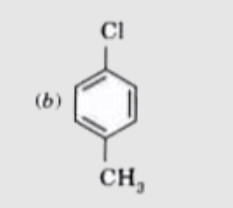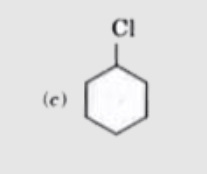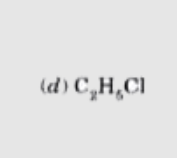Which of the following will be least reactive towards nucleophilic substitution reaction ?
To determine which compound is least reactive towards nucleophilic substitution reactions, we need to analyze the given options based on the presence of functional groups, the type of bonds, and the potential for resonance or conjugation.
1. Identify the Compounds:
We need to look at the compounds provided in the options. Let's denote them as A, B, C, and D for clarity.
2. Understand Nucleophilic Substitution:
In nucleophilic substitution reactions, a nucleophile attacks the electrophilic carbon atom, leading to the replacement of a leaving group (like a halogen). The reactivity of the compound depends on the stability of the leaving group and the nature of the carbon atom bonded to it.
3. Analyze Option A:
If Option A contains a simple alkyl halide (e.g., R-X where R is an alkyl group and X is a halogen), it is generally reactive because there are no resonance effects or steric hindrance.
4. Analyze Option B:
If Option B contains a halogen attached to a carbon that is part of a conjugated system (e.g., a double bond or aromatic ring), the lone pairs on the halogen can participate in resonance. This resonance stabilizes the molecule and makes it less reactive towards nucleophilic substitution because the bond to the halogen becomes stronger due to the partial double bond character.
5. Analyze Option C:
If Option C is another simple alkyl halide without any conjugation, it will also be reactive towards nucleophilic substitution similar to Option A.
6. Analyze Option D:
If Option D is similar to Option C, it will also be reactive.
7. Compare Reactivity:
Based on the analysis, Option B, which has resonance stabilization due to the presence of a conjugated system, will be the least reactive towards nucleophilic substitution. The presence of a partial double bond character makes it difficult for the nucleophile to attack and replace the leaving group.
8. Conclusion:
Therefore, the compound that is least reactive towards nucleophilic substitution is Option B.
We need to look at the compounds provided in the options. Let's denote them as A, B, C, and D for clarity.
In nucleophilic substitution reactions, a nucleophile attacks the electrophilic carbon atom, leading to the replacement of a leaving group (like a halogen). The reactivity of the compound depends on the stability of the leaving group and the nature of the carbon atom bonded to it.
If Option A contains a simple alkyl halide (e.g., R-X where R is an alkyl group and X is a halogen), it is generally reactive because there are no resonance effects or steric hindrance.
If Option B contains a halogen attached to a carbon that is part of a conjugated system (e.g., a double bond or aromatic ring), the lone pairs on the halogen can participate in resonance. This resonance stabilizes the molecule and makes it less reactive towards nucleophilic substitution because the bond to the halogen becomes stronger due to the partial double bond character.
If Option C is another simple alkyl halide without any conjugation, it will also be reactive towards nucleophilic substitution similar to Option A.
If Option D is similar to Option C, it will also be reactive.
Based on the analysis, Option B, which has resonance stabilization due to the presence of a conjugated system, will be the least reactive towards nucleophilic substitution. The presence of a partial double bond character makes it difficult for the nucleophile to attack and replace the leaving group.
Therefore, the compound that is least reactive towards nucleophilic substitution is Option B.
Topper's Solved these Questions
- HALOALKANES AND HALOARENESBOOK - MODERN PUBLICATIONCHAPTER - HALOALKANES AND HALOARENESEXERCISE - CONCEPTUAL QUESTIONS
25 Videos
- HALOALKANES AND HALOARENESBOOK - MODERN PUBLICATIONCHAPTER - HALOALKANES AND HALOARENESEXERCISE - NCERT In-text Questions
9 Videos
- HALOALKANES AND HALOARENESBOOK - MODERN PUBLICATIONCHAPTER - HALOALKANES AND HALOARENESEXERCISE - UNIT PRACTICE TEST
11 Videos
- GENERAL PRINCIPLES AND PROCESSES OF ISOLATION OF ELEMENTSBOOK - MODERN PUBLICATIONCHAPTER - GENERAL PRINCIPLES AND PROCESSES OF ISOLATION OF ELEMENTSEXERCISE - COMPETION FILE (Integer Type Numerical Value Type Questions)
5 Videos
- ORGANIC COMPOUNDS CONTAINING NITROGEN BOOK - MODERN PUBLICATIONCHAPTER - ORGANIC COMPOUNDS CONTAINING NITROGEN EXERCISE - UNIT PRACTICE TEST
5 Videos
Similar Questions
Knowledge Check
Which of the following is least reactive towards nucleophilic substitution?
A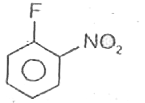 B
B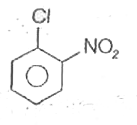 C
C D
D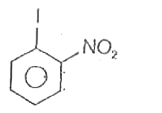
Which of the following is the most reactive towards nucleophilic substitution reaction ?
ACH2=CH−ClBC6H5ClCCH3CH=CHClDClCH2−CH=CH2Which of the following is the most reactive towards nucleophilic substitution reaction?
ACH2=CH−ClBC6H5ClCCH3CH=CHClDClCH2−CH=CH2
Which of the following is least reactive towards nucleo- philic substitution?
View SolutionWhich of the following will be least reactive in nucleophilic substitution ?
View SolutionWhich one of the following is most reactive towards nucleophilic substitution reaction ?
View SolutionWhich of the following is most reactive toward nucleophilic substitution reaction ?
View SolutionWhich of the following is most reactive towards nucleophilic substitution reaction?
View Solution

